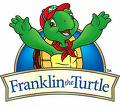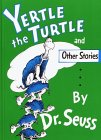|
|
Of all the reptiles that people enjoy watching, the turtle
is the one that people seem to find the most cute and
humorous. Consequently, turtles are often depicted in
literature. Even today turtles spark children's stories and as
symbolic figures in adult novels. Many turtles depicted in
stories are anthropomorphic, meaning that they have both
human and animal characteristics.
For one example, Franklin, the turtle in a popular Canadian
and American children's story, is often seen both in books
and on television shows. Aesop's Fable "The Tortoise and the
Hare," tells the story of a hare in a race with a tortoise.
The hare is beaten by the tortoise when, assured of his win
because of the slowness of the turtle, the hare decides to
take a nap. The slow but steady turtle keeps on and wins the
race, proving that perseverance is more valuable than simple
ability.

"Yertle the Turtle" by children's author Dr. Seuss, is King
Turtle of the pond kingdom Salamasond. He decides that he
wants to look out across all his kingdom, so he orders all
the other turtles in his pond to stack themselves beneath
him so that he can stand on top of them to see his vast
wealth. But in the end he falls into the mud and learns that
it is not wise to think too highly of oneself.

Michael Ende's book "Momo" (1973) features the tortoise
Cassiopeia, who can see into the future and display messages
on her shell. "The Neverending Story" (1979) has the giant,
wise swamp turtle Morla.
In the book "Hypnerotomachia Poliphili" (1499), is an
engraving of a woman holding a pair of outspread wings in
one hand and a turtle in the other. This symbolism in novels
depicts the wings representing uplifting and spiritual
things and the turtle as representing slowness and
stagnation.
John Steinbeck uses the tortoise in his classic book, "The
Grapes of Wrath," as a symbol of the resolve and
perseverance of the "Okies," who suffered much but kept on
traveling west across the United States in search of a
better life.
In Terry Pratchett's series of books, the Discworld is
carried on the back of the gigantic star-turtle Great
A'Tuin. In the Discworld novel "Small Gods," the Great God
Om makes his appearance as a tortoise.
An example of a humorous use of the turtle in literature is
the character called the Mock Turtle in Lewis Carroll's
"Alice's Adventures in Wonderland." One very popular edition
of the book is illustrated by John Tenniel. In his
illustration of the Mock Turtle, it is depicted as a turtle
with the head of a calf, arms that resemble oysters, and the
back legs of a sheep, all referencing the real ingredients
of the recipe, Mock Turtle Soup.
Some other literary works also feature turtles and tortoises
but only give them brief mention as a secondary or even
third character of little consequence to the outcome of the
story. But the stories that do feature turtles or tortoises
as a greater aspect of the story usually have a whimsical
feel, and that is why you find turtles in children's stories
primarily. Any way you look at it, turtles are a great
literary animal and many when asked will say that their
favorite animal in a storybook is often a turtle or tortoise.
|